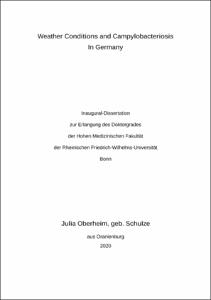Weather Conditions and Campylobacteriosis In Germany

Weather Conditions and Campylobacteriosis In Germany

| dc.contributor.advisor | Kistemann, Thomas | |
| dc.contributor.author | Oberheim, Julia | |
| dc.date.accessioned | 2020-12-16T14:11:28Z | |
| dc.date.available | 2020-12-16T14:11:28Z | |
| dc.date.issued | 16.12.2020 | |
| dc.identifier.uri | https://hdl.handle.net/20.500.11811/8852 | |
| dc.description.abstract | Foodborne Campylobacter species are the most common causes of bacterial gastrointestinal infections in Germany. Campylobacteriosis incidence in temperate climates shows a seasonal pattern which previous studies have attributed to climatic and non-climatic factors. In Germany, the association of campylobacteriosis and weather condition has already been examined on a low resolution and for selected regions. However, to define ranges of weather parameters that strongly correlate with incidences, a dense spatial and temporal data resolution is required.
This study applies a novel approach, examining the correlation between weather parameters, such as temperature and precipitation, and human campylobacteriosis in Germany from 2001 to 2014. Therefore, daily weather data and weekly reported incidences on the NUTS-3 level were examined, which provided a dense temporal and spatial resolution and a statistically robust data background for analysis. The data were sorted based on weather condition and grouped in equally large classes to solve the problem of shrinking numbers of reports in extreme weather conditions. The applied method manages the small numbers problem in lowly populated areas by recalculating incidences from class cases and class populations. Lag times between weather condition and incidence for up to eight weeks were tested. A sigmoid regression was fitted to the data. The regression analysis showed a strong positive correlation between all tested temperature and precipitation parameters and local human campylobacteriosis incidence in Germany. A rise in temperature correlated stronger with increasing incidence than a rise in precipitation. Among all temperature aspects, within a wide temperature corridor of -5 °C to 28 °C incidence increased with rising ambient temperature. Among the tested temperature parameters, the weekly average of daily minimum temperature was identified as most significant with the most pronounced incidence increase within a temperature corridor of approximately 0 °C to 12 °C. The correlation for the minimum temperature occurred with an offset of two weeks and for the weekly mean and maximum temperature with an offset of four to five weeks. The strongest correlation among all precipitation parameters occurred at the four-week total precipitation with a time offset of approximately two weeks to incidence. Overall, the present small-scale data analysis gives evidence of the crucial role increasing mild minimum temperatures play in campylobacteriosis incidence. However, since increasing ambient temperatures have diametrical effects on Campylobacter survival and furthermore replication is unlikely outside the host, Campylobacter’s microbiology cannot explain the study results. It is more likely that other variables such as vectors or human behaviour are more directly linked with temperature parameters than the pathogen itself. These other variables outweigh the direct relationship between temperature and pathogen when the whole chain of infection is considered. Therefore, it was assumed that campylobacteriosis incidence is the integral of multiple interdependent factors. Among them, ambient temperature is one contributing factor and could act as an indicator of elevated human exposure towards Campylobacter. Regarding precipitation parameters, the results show that high precipitation is strongly associated with campylobacteriosis incidence which can be explained with the pathogen’s microbiology. Rain peaks are likely to be more influential than frequent low dose rain. The study results demonstrate that campylobacteriosis is strongly associated with ambient temperature and precipitation. It gives evidence of an increased incidence with projected warmer temperatures and an increase in heavy rain events in the context of climate change. However, the driving weather-susceptible mechanism is likely to act beyond the direct weather-pathogen relationship and is yet to be identified. | en |
| dc.language.iso | eng | |
| dc.rights | In Copyright | |
| dc.rights.uri | http://rightsstatements.org/vocab/InC/1.0/ | |
| dc.subject | Campylobacteriose | |
| dc.subject | Wetter | |
| dc.subject | Infektionserkrankungen | |
| dc.subject | Lebensmittelinfektionen | |
| dc.subject | Klimawandel | |
| dc.subject | campylobacteriosis | |
| dc.subject | weather | |
| dc.subject | infectious diseases | |
| dc.subject | foodborne diseases | |
| dc.subject | climate change | |
| dc.subject.ddc | 610 Medizin, Gesundheit | |
| dc.title | Weather Conditions and Campylobacteriosis In Germany | |
| dc.type | Dissertation oder Habilitation | |
| dc.publisher.name | Universitäts- und Landesbibliothek Bonn | |
| dc.publisher.location | Bonn | |
| dc.rights.accessRights | openAccess | |
| dc.identifier.urn | https://nbn-resolving.org/urn:nbn:de:hbz:5-60752 | |
| ulbbn.pubtype | Erstveröffentlichung | |
| ulbbn.birthname | Schulze | |
| ulbbnediss.affiliation.name | Rheinische Friedrich-Wilhelms-Universität Bonn | |
| ulbbnediss.affiliation.location | Bonn | |
| ulbbnediss.thesis.level | Dissertation | |
| ulbbnediss.dissID | 6075 | |
| ulbbnediss.date.accepted | 09.12.2020 | |
| ulbbnediss.institute | Medizinische Fakultät / Institute : Institut für Hygiene und öffentliche Gesundheit | |
| ulbbnediss.fakultaet | Medizinische Fakultät | |
| dc.contributor.coReferee | Mayr, Andreas |
Dateien zu dieser Ressource
Das Dokument erscheint in:
-
E-Dissertationen (2103)




